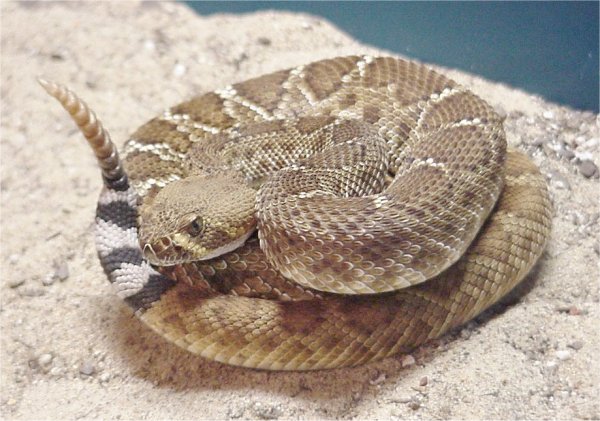
Red diamond rattlesnake. Courtesy of LA Dawson ( CC BY-SA 2.5)
CC BY-SA 2.5)  via Wikimedia Commons
via Wikimedia Commons
January 28 marks Rattlesnake Appreciation Day. This is a good time to appraise our instinctual fears and celebrate our rattlesnakes.
For many years rattlesnakes were considered dangerous vermin and killed indiscriminately. Today a more nuanced view is taking hold. Rattlesnakes have been part of the ecosystem for 10 million years and should be respected for being another of nature’s predators.
While over 3000 people die in auto accidents in California each year, the state averages less than one snakebite death annually. We should be more afraid of our cars than our snakes!
California is home to ten rattlesnake taxa. CNDDB tracks one of those, the red-diamond rattlesnake (Crotalus ruber) which is a state Species of Special Concern. The primary threats to this species are urbanization and fragmentation of habitat.
Crotalus ruber can be found in the far southwestern portion of California, with a range extending from Los Angeles County south throughout most of the Baja California Peninsula. While rodents make up most of its diet, the species is also known to take rabbits, skunks, lizards, and birds. Typical habitat includes rocky areas within chaparral or woodland below 3000 feet in elevation.
Fun fact: You may already know that rattlers can sense both the light and heat coming off their prey, but did you know their olfactory system provides them with a directional sense of smell?
Use today as an opportunity to spread a little rattlesnake appreciation. Maybe show a child an online video demonstrating the hunting prowess of a Crotalus. You’ll be sure to get that kid’s attention. Point out that rattlers fill a predatory niche similar to hawks and bobcats. Remember that people don’t work to protect what they don’t understand. Today’s children will become tomorrow’s leaders.
Of course, we would be remiss if we failed to mention that a rattlesnake bite may result in serious injury and should always be considered a medical emergency. Keep some distance, appreciate our rattlesnakes through your telephoto lens, and submit any detections of red-diamond rattlers through our Online Field Survey Form.
For more information on sharing the land with our rattlesnake neighbors visit the CDFW Keep Me Wild page.